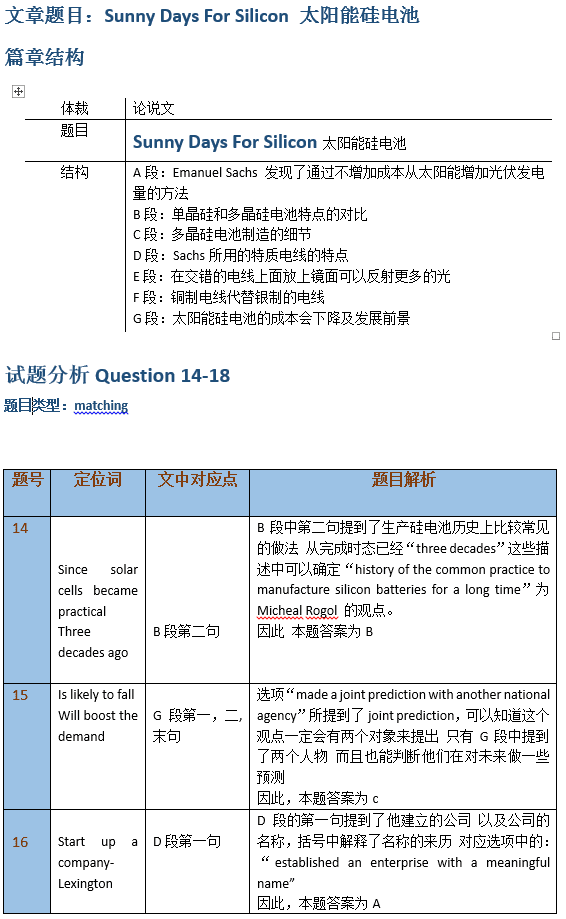由于GRE词汇量大的特点,在GRE阅读中遭遇陌生词汇可以说是再正常不过的一件事。下面小编就和大家分享GRE阅读如何应对生词难词问题 ,来欣赏一下吧。
GRE阅读如何应对生词难词问题
1. 下定义法
这个方法在GRE阅读考试中的运用还是很普遍的,多用于描述一个新专业,新领域,新单词。而且在文章首段出现的频率最高,因为文章首段通常都是为本文话题或标题下定义。
例:Archaeology is partly the discovery of the treasures of the past, partly the careful workof the scientific analyst, partly the exercise of the creative imagination.(“The Nature And Aims of Archaeology”) 从“is”这个词不难发现后面的部分都是为archaeology下定义:对过去财物的发掘,细致的科学分析,创造力的想象------考古学(以-ology为后缀都是表示某门学科)。
例:Theseasonal impact of day length on physiological responses is calledphotoperiodism. (“The effects of light on plant and animal species”) “is called”的前半句也起了解释说明的作用:日长的生理反应称为光周期的季节性影响。
2. 符号法
无论是练习还是模考时,在阅读中我们常会发现某个单词或词组,乃至句子的前后常会出现一些特殊符号,比如:破折号(—),冒号(:),小括号(),引号(“ ”)。这些符号都是帮助大家猜测生词的线索,它们的前后通常都是对GRE阅读词汇的解释和说明。
例:Generally,the rates have been modest (lower than bank rates). ( “Micro-Enterprise Creditfor Street Youth”) 括号里的部分是对其前面的modest做说明,即比银行的利息低一些。
例:Inall cases, someone has to act as a source of language data--- informant.Informant指的是充当语言资料来源的人。需要提示的是,经常会在小括号里出现i.e, 意思是that is to say.
3. 举例子
GRE阅读试题经常会在某个潜在生词的后面,举出一系列的例子,此时,大家可以根据例子,总结它们的共性。举例子的一些标志词:for example,for instance,such as,just like,e.g.
4. 句子之间的关联词
句子之间的关联词主要分为转折和并列,透露了两句之间表达意思的方向性是否一致。我们完全可以通过已知的半句所表述的涵义,借助关联词,来推测另外半句的意思。
并列关系:and,similarly,equally,also,both … and…
转折关系:but,however,yet,instead,nevertheless,by contrast,on the other hand
例:International commerce was therefore dominated by raw materials,such as wheat,wood and ironore,or processed commodities,such as meat and steel. (“Delivering The Goods”)“or”表示或者,虽然是并列关系,但在意思上是相反的。Processed commodities不难理解是加工过的产品,那“or”前面的句子指的就该是没有加工过的产品,即raw materials,原材料。
5. 常识和上下文
常识和上下文也是作为揣测词义的一个有效途径,而这里所言的常识是涉及各领域,学科,平时累积而成,众所周知的知识,常理。
例:The earliest method of making fire was through friction. European peasants would insert a wooden drill in a round hole and rotate it briskly between their palms. (“How Fire Leapt to Life”) 最早的取火方式是钻木取火,其原理是摩擦生热。通过下文的例子也可看出这一点。欧洲的农民会把一个木制的钻头插入一个圆形的洞,然后在手掌间迅速的旋转它。Friction就是摩擦的意思。
6. 同位语
同位语是指一个名词(或其它形式)对另一个名词或代词进行修饰,限定或说明,这个名词(或其它形式)就是同位语。同位语与被它限定的词的格要一致,并常常紧挨在一起,常出现在句子中间或者后面的位置。
例:One of the most important new methodologies is biomechanics, the study of the body in motion. (“How much higher?How much faster?”) 有时候同位语的解释更让人容易理解和接受,biomechanics专业说法是生物力学,而同位语的表达更平易近人:对身体运动的研究。
综上所述,在GRE阅读中遭遇生词,并不代表自己的词汇背诵没有到位,考生也大可不必因此出现情绪波动,按照上文方法,解决这些生词并非难事
GRE阅读快速读文章技巧方法汇总介绍
什么是略读技巧
GRE阅读的略读技巧主要有以下几个特点:
1. 以极快的速度阅读文章,寻找字面上或事实上的主要信息和少量的阐述信息。
2. 可以跳过某个部分或某些部分不读。
3. 理解水平可以稍低一些,但也不能太低。
如何在GRE阅读中使用略读技巧
1. 要利用文章结构上的各种常见细节,如文章的标题、副标题、小标题、斜体词、黑体词、脚注、标点符号等,对文章进行预测略读(preview skimming)。预测略读要了解作者的思路、文章方式(模式),以便把握大意,有关的细节及其相互关系。
2. 以一般阅读速度(200~250wpm)阅读GRE阅读文章开头的一、二段,力求抓住文章大意,背景情况,作者的文章风格,口吻或语气等。
3. 阅读段落的主题句和结论句。抓住主题句就掌握了段落大意,然后略去细节不读,以求得略读速度,这一点是GRE快速阅读技巧要抓住的最重要的一点。
4. 注意转折词和序列词。转折词如however,moreover,in addition等;序列词如firstly,secondly等。
略读是实用的GRE快速阅读技巧,通过略读大家可以既节省时间又抓住文章的主要内容,但是这个技巧的掌握需要不断地练习和有意识的培养,因此希望各位同学在平时的备考练习中就学会使用这种技巧,并应用到考试中。如此一来,就能更好地理解GRE阅读文章,留出足够时间研究题目并保证正确率。
GRE阅读真题
The condition of scholarship devoted to the history of women in photography is confounding. Recent years have witnessed the posthumous inflation of the role of the hobbyist Alice Austen into that of a pioneering documentarian while dozens of notable senior figures—Marion Palfi, whose photographs of civil-rights activities in the South served as early evidence of the need for protective legislation, to name one— received scant attention from scholars. And, while Naomi Rosenblum’s synoptic History of Women Photographers covers the subject through 1920 in a generally useful fashion, once she reaches the 1920s, when the venues, forms, applications, and movements of the medium expanded exponentially, she resorts to an increasingly terse listing of un-familiar names, with approaches and careers summarized in a sentence or two.
1. The author of the passage cites Rosenblum’s book most likely in order to
A. suggest that the works documented most thoroughly by historians of women in photography often do not warrant that attention
B. offer an explanation for the observation that not all aspects of the history of women in photography have received the same level of attention
C. provide an example of a way in which scholarship on the history of women in photography has been unsatisfactory
D. suggest that employing a strictly chronological approach when studying the history of women in photography may be unproductive
E. provide support for the notion that certain personalities in women’s photography have attained undue prominence
For the following question, consider each of the choices separately and select all that apply.
2. Which of the following statements about Marion Palfi is supported by the passage?
A. Marion Palfi’s photographs would have received greater recognition from historians had her work been done in an era when most aspects of photography were static rather than in a state of transition.
B. Alice Austen has achieved greater notoriety than has Marion Palfi primarily because the subjects that Austen photographed were more familiar to her contemporaries.
C. In addition to providing a record of certain historical events, Marion Palfi’s photographs played a role in subsequent events.
3. In the context in which it appears, “inflation” (line 2) most nearly means
A. exaggeration
B. acquisition
C. evaluation
D. distortion
E. attenuation
GRE阅读真题
The evolution of intelligence among early large mammals of the grasslands was due in great measure to the interaction between two ecologically synchronized groups of these animals, the hunting carnivores and the herbivores that they hunted. The interaction resulting from the differences between predator and prey led to a general improvement in brain functions; however, certain components of intelligence were improved far more than others.
The kind of intelligence favored by the interplay of increasingly smarter catcher sand increasingly keener escapers is defined by attention — that aspect of mind carrying consciousness forward from one moment to the next. It ranges from a passive, freefloating awareness to a highly focused, active fixation. The range through these states is mediated by the arousal system, a network of tracts converging from sensory systems to integrating centers in the brain stem. From the more relaxed to the more vigorous levels, sensitivity to novelty is increased. The organism is more awake, more vigilant; this increased vigilance results in the apprehension of ever more subtle signals as the organism becomes more sensitive to its surroundings. The processes of arousal and concentration give attention its direction. Arousal is at first general, with a flooding of impulses in the brain stem; then gradually the activation is channeled. Thus begins concentration, the holding of consistent images. One meaning of intelligence is the way in which these images and other alertly searched information are used in the context of previous experience. Consciousness links past attention to the present and permits the integration of details with perceived ends and purposes.
The elements of intelligence and consciousness come together marvelously to produce different styles in predator and prey. Herbivores and carnivores develop different kinds of attention related to escaping or chasing. Although in both kinds of animal, arousal stimulates the production of adrenaline and norepinephrine by the adrenal glands, the effect in herbivores is primarily fear, whereas in carnivores the effect is primarily aggression. For both, arousal attunes the animal to what is ahead. Perhaps it does not experience forethought as we know it, but the animal does experience something like it. The predator is searchingly aggressive, inner-directed, tuned by the nervous system and the adrenal hormones, but aware in a sense closer to human consciousness than, say, a hungry lizard’s instinctive snap at a passing beetle. Using past events as a framework, the large mammal predator is working out a relationship between movement and food, sensitive to possibilities in cold trails and distant sounds—and yesterday’s unforgotten lessons. The herbivore prey is of a different mind. Its mood of wariness rather than searching and its attitude of general expectancy instead of anticipating are silk-thin veils of tranquility over an explosive endocrine system.
1. The author refers to a hungry lizard (line 31) primarily in order to
A. demonstrate the similarity between the hunting methods of mammals and those of nonmammals
B. broaden the application of the argument by including an insectivore as an example
C. make a distinction between higher and lower levels of consciousness
D. provide an additional illustration of the brutality characteristic of predators
E. offer an objection to suggestions that all animals lack consciousness line
2. It can be inferred from the passage that in animals less intelligent than the mammals discussed in the passage
A. past experience is less helpful in ensuring survival
B. attention is more highly focused
C. muscular coordination is less highly developed
D. there is less need for competition among species
E. environment is more important in establishing the proper ratio of prey to predator
3. According to the passage, improvement in brain function among early large mammals resulted primarily from which of the following?
A. Interplay of predator and prey
B. Persistence of free-floating awareness in animals of the grasslands
C. Gradual dominance of warm-blooded mammals over cold-blooded reptiles
D. Interaction of early large mammals with less intelligent species
E. Improvement of the capacity for memory among herbivores and carnivores
4. According to the passage, as the process of arousal in an organism continues, all of the following may occur EXCEPT
A. the production of adrenaline
B. the production of norepinephrine
C. a heightening of sensitivity to stimuli
D. an increase in selectivity with respect to stimuli
E. an expansion of the range of states mediated by the brain stem
\
GRE阅读如何应对生词难词技巧
,来欣赏一下吧。GRE阅读如何应对生词难词问题1. 下定义法这个方法在GRE阅读考试中的运用还是很普遍的,。下面小编给大家分享GRE阅读如何应对生词难词技巧,希望能帮助到大家。 GRE阅读如何应对生词难词技巧文档下载网址链接:
上一篇:2020雅思阅读备考策略
下一篇:返回列表






